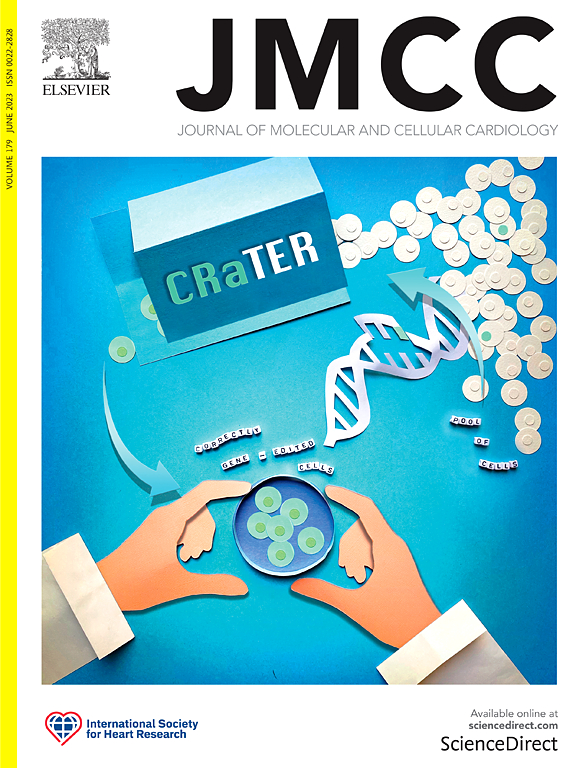MOG1与心脏钠通道Nav1.5胞内环II相互作用的分子机制及其在心律失常中的作用。
IF 4.7
2区 医学
Q1 CARDIAC & CARDIOVASCULAR SYSTEMS
引用次数: 0
摘要
SCN5A编码心脏钠通道α-亚基Nav1.5,其变异可引起长QT综合征(LQTS)、Brugada综合征(BrS)等心律失常。然而,MOG1与Nav1.5相互作用增加心脏钠电流密度的分子机制仍不明确。本研究的目的是确定MOG1和Nav1.5细胞内环路II之间相互作用的关键结构元件,并确定这种相互作用对心律失常的意义。采用全细胞膜片钳法记录tsA201和新生大鼠原代心肌细胞中的钠电流INa。谷胱甘肽s -转移酶(GST)下拉试验用于表征蛋白质-蛋白质相互作用。诱变用于产生缺失和点突变。Nav1.5 Loop II 940-1200的大缺失和小缺失将mog1相互作用域定义为V1190-H1200。点突变分析显示,氨基酸R1195、Y1199和H1200参与了MOG1-Nav1.5 Loop II互作。来自人类患者的mog1相互作用域的两个变体显示出重要的功能作用。变异p.R1195C在两例ClinVar心律失常患者中被发现,削弱了Nav1.5和MOG1之间的相互作用,降低了MOG1增强的心脏钠电流密度。变异p.Y1199S在1例LQTS患者和1例心律失常患者中被鉴定出,产生晚期INa,削弱Nav1.5和MOG1之间的相互作用,降低MOG1增强的心脏钠电流密度。本研究鉴定了Nav1.5 Loop II中与MOG1相互作用的三个关键氨基酸R1195、Y1199和H1200,揭示了MOG1相互作用域p.R1195C和p.Y1199S变异体导致LQTS和心律失常的分子机制。本文章由计算机程序翻译,如有差异,请以英文原文为准。

Molecular mechanism for the interaction of MOG1 with the intracellular loop II of cardiac sodium channel Nav1.5 and its role in arrhythmias
SCN5A encodes the cardiac sodium channel α-subunit Nav1.5, and its variants cause long QT syndrome (LQTS), Brugada syndrome (BrS) and other arrhythmias. MOG1 interacts with Nav1.5 to increase cardiac sodium current densities, however, molecular mechanisms remain poorly defined. The objectives of this study were to identify the crucial structural elements responsible for the interaction between MOG1 and Nav1.5 intracellular Loop II, and determine the significance of this interaction to cardiac arrhythmias. Whole-cell patch-clamping was used to record sodium current INa in tsA201 and neonatal rat primary cardiomyocytes. Glutathione S-transferase (GST) pull-down assays were used to characterize protein-protein interactions. Mutagenesis was used to create deletions and point mutations. Characterization of large deletions and small deletions of Nav1.5 Loop II 940–1200 defined the MOG1-interacting domain to V1190-H1200. Point mutation analysis revealed that amino acids R1195, Y1199 and H1200 were involved in MOG1-Nav1.5 Loop II interaction. Two variants of MOG1-interacting domain from human patients showed important functional effects. Variant p.R1195C was identified in two individuals with cardiac arrhythmias in ClinVar, weakened the interaction between Nav1.5 and MOG1, and reduced MOG1-enhanced cardiac sodium current densities. Variant p.Y1199S was identified in one individual with LQTS and one with cardiac arrhythmias, generated late INa, weakened the interaction between Nav1.5 and MOG1, and reduced MOG1-enhanced cardiac sodium current densities. This study identifies three critical amino acids R1195, Y1199 and H1200 of Nav1.5 Loop II for interaction with MOG1, and reveals the molecular mechanisms by which variants p.R1195C and p.Y1199S in MOG1-interacting domain cause LQTS and cardiac arrythmias.
求助全文
通过发布文献求助,成功后即可免费获取论文全文。
去求助
来源期刊
CiteScore
10.70
自引率
0.00%
发文量
171
审稿时长
42 days
期刊介绍:
The Journal of Molecular and Cellular Cardiology publishes work advancing knowledge of the mechanisms responsible for both normal and diseased cardiovascular function. To this end papers are published in all relevant areas. These include (but are not limited to): structural biology; genetics; proteomics; morphology; stem cells; molecular biology; metabolism; biophysics; bioengineering; computational modeling and systems analysis; electrophysiology; pharmacology and physiology. Papers are encouraged with both basic and translational approaches. The journal is directed not only to basic scientists but also to clinical cardiologists who wish to follow the rapidly advancing frontiers of basic knowledge of the heart and circulation.

 求助内容:
求助内容: 应助结果提醒方式:
应助结果提醒方式:


